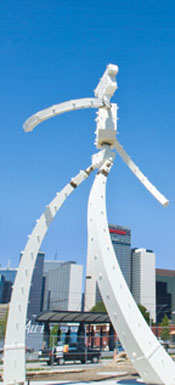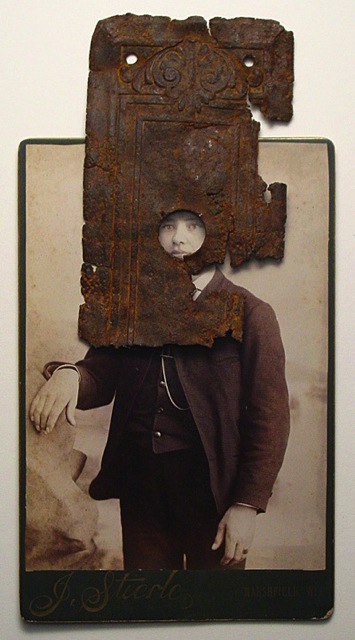Yep, all those glowing little windows were my idea. Five years ago, under their Station Art & Design program, DART named me Station Artist. My job was to create a public art concept for this sleekly sculpted light rail facility. Now it’s just months from opening, and I bet you can’t guess what’s inside all those windows. Or rather, to my chagrin, what was supposed to be inside them, but isn’t.
To say the least, I’m a bit miffed at DART about the way the whole project turned out. But you have to hand it to them. Their SAD program is a smart, shrewd way to get Dallas suburbs on board with light rail. Here’s how it works.
Whenever a new station is on the drawing board, but especially when local resistance threatens to stand in the way (which is often enough), out come DART’s architects, engineers and public relations executives. A Station Artist is hired and community meetings commence. Suddenly there is dialogue – the airing of grievances and feats of strength. Locals are encouraged to talk about how they’d like their station to look, and gradually any objections just seem to melt away.
The one-eighties have never been more dramatic than the one over the Deep Ellum Tunnel. Neighborhood arties and Plano teens alike loved that mural-and-graffiti-glazed landmark, 1) for really sticking it to the man, and 2) for letting you know you’d entered their hard-drinking, hard-puking club district.
The edgy reputation was come by honestly enough though, since Deep Ellum itself has roots in the hardscrabble blues: dominated as it was over the years by blues musicians, blues bars and bluesy African American culture. Even its name tells part of the story: “Ellum” for Elm Street, and “Deep” for the deep end of Elm. That’s the keepin’-it-real end – as opposed to the Crowne Plaza end.

But four years ago as DART chugged its way toward Fair Park, the Tunnel stood in their way, and the agency revealed that to stay on track their Green Line would have to run right over the counter-cultural sacred cow. Advocates raised their voices in protest and immediately DART responded with a sort of Special Edition Super SAD, dangling before Deep Ellum’s many artists and creative types an international competition, the winner of which would design public art to serve as a $1.5 million Deep Ellum Gateway.
The one-eighty part came when the winning concept was revealed: all those rabid defenders of cultural authenticity just rolled on over for a glitzy amusement park mascot: a cutesy, 38-foot tall, stainless-steel cartoon character named Million-Dollar Gumby. Well, okay, so maybe I’m the only one who calls him Million-Dollar Gumby.
In Dallas though, that’s the way we look at art, isn’t it? Like, “we don’t know anything about art but we know what it will get us.” DART’s official SAD brochure rhapsodizes about “the powerful synergy created by a shared vision and collaboration.” I say that’s Vision with a capital V. And that rhymes with D. And that stands for ka-ching.
Nobody would blame a community for jumping at the chance to help design their own train station. I’ll just blame DART, for pretending to value art while cynically using it as a way to get communities to go along. I believe I have the right to say this because the art they’re paying me $15,000 to create – the art the Carrollton community selected for their Downtown Carrollton Station, the art its columns were carefully engineered to hold – that art is, to DART, not worth installing in the 140 glowing little windows.
So, having gone and on about it, what exactly is my Downtown Carrollton Station public art concept, and why was it left out of those glowing little windows? The story goes something like this.
From the moment DART announced its plan to build a light rail station adjacent to Old Downtown Carrollton, residents and business owners feared the massive, bi-level structure and its modern design might overpower not only their town square’s nostalgic charm but also any trace of the site’s historical significance. Ever since the 1870s it had hardly been anything but a rail yard, and while the actual tracks shifted somewhat over the ensuing one hundred forty years, many of those who first settled this area arrived by train and, stepping off, may have first set foot on Texas soil very near where Downtown Carrollton Station would be built.
My assignment as Station Artist was to bring some hint of that historical significance to the Downtown Carrollton Station, and in the tension between present and past, I recognized the opportunity for a redemptive gesture. In 2006, after months of meetings with Carrollton residents and DART representatives, I made my proposal, to memorialize the forgotten heroes who’d migrated there. Onto antique photographic portraits of anonymous Americans, stand-ins for the actual people, I would “collage” the objects and artifacts that would inevitably surface during the site’s excavation. Rather than history being buried, physical evidence of what happened there, maybe even of those who stepped off the first trains, would be recovered and enshrined in the station’s columns. The Carrollton community was satisfied with the concept, and my Heroic Portraits project was approved.
I went to work. As lasers etched into acrylic blocks the scores of vintage photographs I’d collected from antique stores, I scoured the site for artifacts, using among other things a metal detector and a tea strainer. Eventually, to what I’d unearthed over the course of several years, I added items from my own collection of found objects. Finally in late June I prepared to transport bins and boxes, four-years’ worth of digging, to the DART field office for the collage process.

By then, temperatures approached 100 degrees and suddenly their un-air conditioned metal building, having neither lights nor electricity, appeared to be inadequate for the task, so I asked if, when they were finished, I could have the acrylic blocks to collage in my own studio. Several weeks past without a word from DART, and then one night, after being given an imminent deadline but no acrylic and no green light on where to work, I happened to drive past the station and saw for myself those 140 glowing little windows. DART had gone ahead and installed the unfinished acrylic blocks without my ever touching them, let alone seeing them.
I’ll be the first to admit DART’s SAD program truly has enhanced its light rail stations, and I was even an enthusiastic fan, back when their architects, engineers and public relations executives were the first ones in the room for all those Carrollton meetings, back when they seemed to express genuine support and would actually return my calls.
Now I feel a little stupid about how enthusiastic and naive I’d been about the project. For instance, I’d started a blog about Heroic Portraits, explaining the ideas behind it and posting images of artifacts I’d collected. And for a 2008 show of sculpture at Conduit Gallery that incorporated metal I found on the DART site, I even invited the agency to participate, for whatever promotional value and credibility it might give their SAD program within the Dallas art community. But once those meetings had ended, once DART had gotten Carrollton’s approval on the concept and those executives returned to their offices, my efforts to contact them went unanswered.
I’m not saying DART Hates Art, and I truly believe it was only a breakdown in communication within the agency that prevented me from finishing the project as designed. But I wonder if the fact I’d be mounting potentially significant, archaeological artifacts in the columns finally scared somebody. Or could it have been that Million-Dollar Gumby crack? Whatever the reason, DART doesn’t seem to hold art in the high esteem they claim, nor do they seem to care much about their commitment to the Carrollton community. Else they might open those 140 windows so I can install the art I was hired to make. Instead, DART appears to value art only when it opens doors for them.




